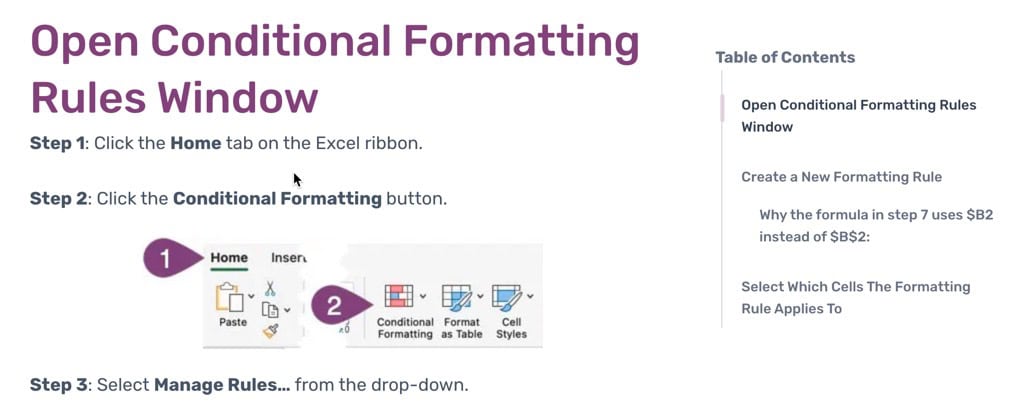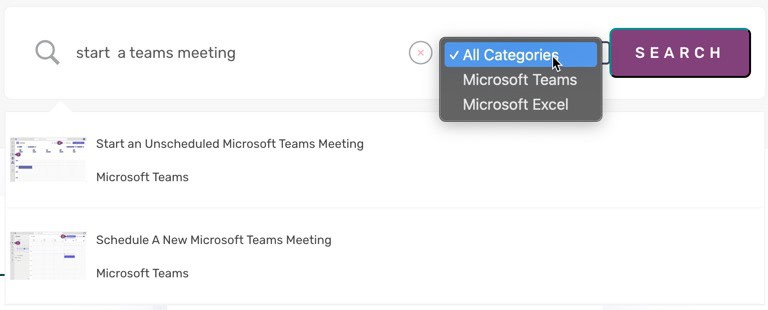Imagine investing countless hours into creating a knowledge base article, only to find that users struggle to find the right help or follow the help they do find. It’s a frustrating scenario for anyone responsible for developing valuable and needed help.
Even with the best intentions, crafting a knowledge base article can become a treacherous path, riddled with common pitfalls that are often unknown to someone new to adult learning and training in general. These errors can not only undermine the effectiveness of documentation but also lead to customer dissatisfaction, confusion, and an increase in support tickets.
One of the primary goals of the knowledge base and training is to reduce the number of support tickets and help desk calls. That’s why it’s essential to understand these common pitfalls and understand that creating quality and effective help articles isn’t as easy as throwing your expert at the task of documenting what they know.
A knowledge base article isn’t software documentation, which isn’t an effective form of training, and shouldn’t be approached in the same way.
We’ll explore how software companies, SaaS platforms, and even internal knowledge bases can build better help for users. Whether you’re writing for an internal team or a public audience, each type of article presents unique challenges.
Build better help for users by avoiding these pitfalls.
From overly technical jargon in company software documentation to the lack of clarity in public-facing SaaS resources, we’ll help you avoid these blunders and get the help you need in the form of instructional design consultants who know how to focus and simplify training to be effective, even in the form of a knowledge base article.
By understanding these pitfalls, you’ll begin to know how to create clear, accessible, and valuable knowledge base articles that truly serve their intended purpose. If not, there’s help only a free consultation away.
The Most Common Pitfalls
These pitfalls may hinder the effectiveness of knowledge base articles, making them difficult to use. Understanding and addressing them ensures your company’s knowledge base articles are clear, concise, and helpful to users seeking information. There’s nothing worse than leaving them empty-handed.
Now it’s time to explore the most common pitfalls, so you know what to avoid and can instead deliver high-quality content that meets users’ needs.
Overuse of Technical Jargon
One of the most common pitfalls when creating a knowledge base article is the unconscious use and overuse of technical jargon and acronyms. If a subject matter expert (SME) also creates the articles, this is almost inevitable. SMEs often don’t realize how much they truly know and take it for granted.
Engineers and developers often assume that their teammates share the same level of expertise. While this may be true within a specialized team, new hires, cross-functional partners, or non-technical people can quickly feel lost in a sea of unfamiliar terms.
When the language in public and even private knowledge base articles becomes too dense, readers waste time deciphering phrasing and getting lost in jargon instead of accomplishing the task at hand. This can slow down work, make it impossible in some cases, increase dependency on support channels, and ultimately decrease productivity.
Jargon can make an article unhelpful and confuse users more than help them.
To avoid this trap, it’s important to keep things simple and separate the knowledge experts from the help article creators. Introduce technical terms only after defining them clearly, and when possible, provide a glossary of acronyms that’s easy to access. Using consistent terminology across your articles ensures users don’t encounter multiple synonyms for the same concept.
Additionally, peer reviews by those less familiar with the subject can highlight areas where jargon isn’t well-defined and confuses things. The goal is to make your knowledge base article inclusive, which means approachable for the correct audience who needs the article to help them accomplish their task.
Lack of Clarity
When publishing knowledge base articles, the audience is vastly broader than your internal team. Customers range from complete beginners to experienced IT professionals, each with unique expectations and skill levels. A major pitfall is assuming everyone understands the basic concepts and skipping over them or generalizing them too much.
Never presume too much foundational knowledge. Conversely, overly verbose explanations can frustrate users who want to get to the how-to steps. Striking a balance between brevity and thorough explanations is essential to clarity.
One way to enhance clarity is through the use of modular content design and making content easy to skim. Break complex topics into smaller, standalone articles or sections. That might mean getting started guides, troubleshooting checklists, and advanced configuration steps. Use clear, descriptive headings so users can scan the article and jump directly to the section relevant to their needs.
An article with a clear intent, steps, and context helps users perform the task they need.
Additionally, employing consistent formatting, such as numbered steps for procedures and bullet points for lists, improves readability. A table of contents makes it easier to jump to the right spot and makes each article clearer.

It’s also nice to include a summary or TL;DR at the top, which sets expectations and lets users know if they’ve landed on the right article. By prioritizing clarity and modularity, you ensure that your public-facing knowledge base articles accommodate a diverse customer base.
Poor Structuring of Information
Many knowledge base articles fail because authors overlook the importance of a logical structure. A poorly organized article forces readers to hunt for information, making the resource more of a hindrance than a help.
When you’re an expert and think your level of expertise is necessary to understand the topic, it’s easy to cram too much detail into every article. It’s also easy to cram too many details into a block of text without subheadings, numbered steps, or summaries, leaving users overwhelmed. A well-structured article guides users through a clear flow of information, accompanied by meaningful visuals that facilitate easy comprehension.
Effective structuring starts with outlining essential topics and subtopics and breaking down tasks into individual articles properly before writing. Use hierarchical headings (H1, H2, H3) judiciously to break content into digestible chunks.
It’s essential to break down articles into individual ideas rather than creating expansive and poorly structured content. Each section should be singularly focused, whether it’s an overview, prerequisites, step-by-step instructions, troubleshooting tips, or additional resources.
Consistent visual formatting, such as callout boxes for warnings or tips, also helps draw attention to critical information. By planning and mapping out articles, as well as their structure, knowledge base articles will be more helpful and valuable to users.
Failure to Address Common User Queries and Concerns
Can users find an article to help them with what they need, or are they endlessly hunting for the right topic?
There’s nothing worse than neglecting to research and address the questions users typically have. Without properly mapping out the initial needs for the software and creating all necessary help articles, the answers won’t be readily available. The problem is compounded if you have no way to collect future needs and turn those into articles, too.
Without real user data, authors often guess at the pain points and may miss critical steps or troubleshooting scenarios that are essential for effective solutions. The result? End-users still need to contact support, and your knowledge base appears to be incomplete.
Obvious gaps in knowledge base article topics are a huge red flag that a company doesn’t value supporting its users.
While it’s impossible to foresee every need, a thorough plan will address the most pressing topics. For anything else, put a process in place to prioritize and create needed help articles.
After the initial creation of articles, analyze support ticket trends and search logs within your help desk or documentation platform. Identify the top five to ten recurring issues or questions, and ensure each is covered sufficiently.
A “Need more help?” prompt linking to related articles, community forums, or a request form is extremely valuable. Regularly solicit feedback via quick in-article surveys or comment fields, then iterate based on user comments. When your knowledge base article directly reflects user expectations, you’ll see a drop in support escalations and an uptick in customer satisfaction.
Neglecting Visual Aids and Examples for Better Comprehension
Relying solely on blocks of text or even numbered steps/lists can make even the clearest instructions difficult to follow. Visual aids, such as screenshots, diagrams, flowcharts, and embedded videos, play a crucial role in enhancing comprehension and understanding. We’re humans, and we like to see stuff rather than try to visualize it.
Without visual elements, users will have a harder time following steps, keeping their spot, and may misinterpret steps. All this will likely lead to frustrated users. A knowledge base article that lacks visual context often feels cold and inaccessible.
Integrating visual content strategically and consistently makes knowledge base articles more helpful, easier to follow, and even scannable. Capture screenshots that highlight specific UI elements, annotate them with callouts, numbers, or arrows, and ensure they are clear and up-to-date, as with all training.
For complex workflows, consider using flowcharts or process diagrams to map out actions and decision points. Short microlearning-type screen-recording videos can demonstrate multi-step processes that are more difficult to show in a static image, allowing users to see exactly what to click and how the interface responds to their interaction.
Always accompany visuals with alt text to ensure accessibility and aid in search indexing. By blending text with high-quality visual aids and real-world examples, knowledge base articles will be transformed into an engaging, easy-to-follow resource that also ranks well in search engines and potentially attracts customers too.
Ignoring the Importance of Regular Updates and Maintenance
Even the most thorough knowledge base article becomes obsolete or worse, deceptive if it isn’t updated to reflect product changes, software upgrades, or evolving customer needs. Outdated documentation leads to confusion, incorrect configurations, and increased support volume.
If articles were produced during the product launch phases, they’ll reflect that point in time only. Then, things often change rapidly in the software world, causing help articles to lose accuracy quickly. This neglect erodes trust in the knowledge base over time.
Implementing a maintenance schedule is key. Assign ownership of each article and implement a process for revisiting articles to review and update content on a cadence that makes sense, possibly after each product release.
Outdated articles are more harmful than no article at all.
Tracking changes in release notes and feature roadmaps can help you keep track of which articles need to be updated. Ensuring that the date of the last update is available to users will encourage more trust in the knowledge base overall.
Consistent maintenance ensures that your knowledge base remains a reliable source of truth, reducing the risk of outdated procedures and causing distrust, work disruptions, and a burden on the help desk.
Not Optimizing for Search Engine Visibility and Accessibility
Whether your knowledge base article is public-facing or confined behind login walls, discoverability matters. If users can’t find relevant articles via search, internal or external, they’ll resort to calling the service desk or, worse, get into the habit of going directly to the help desk.
Optimizing content with relevant keywords, metadata, and descriptive headings is helpful. If targeting a public audience, poor SEO practices mean your articles won’t rank well in search engines, which is where some users might go instead of your knowledge base search. Optimizing content also helps the knowledge base search function more effectively.
Every article should be complete with all the typical metadata fields a blog post might have, such as page titles and meta descriptions.
Enhance accessibility by following WCAG guidelines. By improving both SEO and accessibility, you empower every user to locate and use your knowledge base articles.
Lack of User-Friendly Navigation and Search Functionality
Even well-written articles can go unread if users can’t navigate your knowledge base or find the article in search. Poorly designed menus, flat hierarchies, or ineffective search tools force users into a frustrating hunt for answers.
Without intuitive navigation, users abandon self-help and flood your support channels with avoidable questions. Once users become accustomed to relying on others for help, they can start to develop a habit of learned helplessness, making it a significant challenge to encourage them to seek self-help again. A knowledge base article is only as valuable as a user’s ability to access it.
Enhance navigation by categorizing content into clear, logical sections, such as Getting Started, Troubleshooting, and Advanced Guides. Use breadcrumb trails and “Related Articles” to guide users toward relevant topics.
Robust search functionality is as essential as organizing content. Features like autocomplete suggestions and visual search results with context reduce search failures. Regularly review search analytics to identify zero-result queries and optimize content or metadata accordingly.

When articles live within an intuitive, well-organized knowledge base, you make it easier to find information and elevate user satisfaction.
The Impact of Poorly Crafted Knowledge Base Articles on Customer Experience
There are numerous drawbacks to having knowledge base articles that aren’t up to par. Ultimately, your customers and bottom line pay the price for the negative experience of poorly crafted articles.
The dreaded crappy KB article likely leads to frustrated users, delayed problem resolution, damage to brand reputation, and the worst part, bloated support requests that have to be answered individually instead of en masse. Frustration often leads customers to abandon self-service and resort to live chat, email support, or phone support, which is expensive and inefficient.
Poorly crafted knowledge base articles harm the company and users. They’ll program users to avoid self-help and go straight to email, chat, and phone.
In competitive SaaS markets, slow or inaccurate support experiences can lead to churn and erode customer lifetime value. Then there’s the problem with internal teams relying on sloppy documentation, which makes it difficult for them to perform their tasks. Some help desk teams use the knowledge base articles to find solutions, too, so now they’re offering poor-quality support that takes a lot of time to find the correct resolution.
This ripple effect reduces overall productivity and can create misaligned messaging between customer success, sales, and development teams.
Conversely, high-quality, well-maintained knowledge base articles streamline support workflows, empower users to help themselves, and reinforce confidence in your product. Investing in effective, accessible documentation directly translates into improved customer experience and reduced support overhead.
Wrap Up
Crafting a truly effective knowledge base article requires more than just writing skills and topic knowledge; it demands user empathy, strategic structure, and ongoing maintenance. Begin by simplifying complex jargon, structuring content clearly, and anticipating real user questions. Enrich your articles with relevant visuals, optimize for discoverability, and ensure seamless navigation.
Commit to regular reviews and updates to keep information accurate, and measure success by monitoring search analytics and support-ticket volumes.
By following these best practices, your knowledge base becomes a powerful tool for empowering users, reducing support costs, and enhancing overall customer satisfaction. We work with SaaS companies as well as internal teams to develop custom knowledge base solutions, including effective articles with your platform or even a custom platform.
If you have any questions about how we can help you improve the effectiveness of self-help for users, schedule a free consultation and learn how we can work with you to improve your business through knowledge base articles. If you’d like to see an example of quality knowledge base articles, check out our sample knowledge base.
